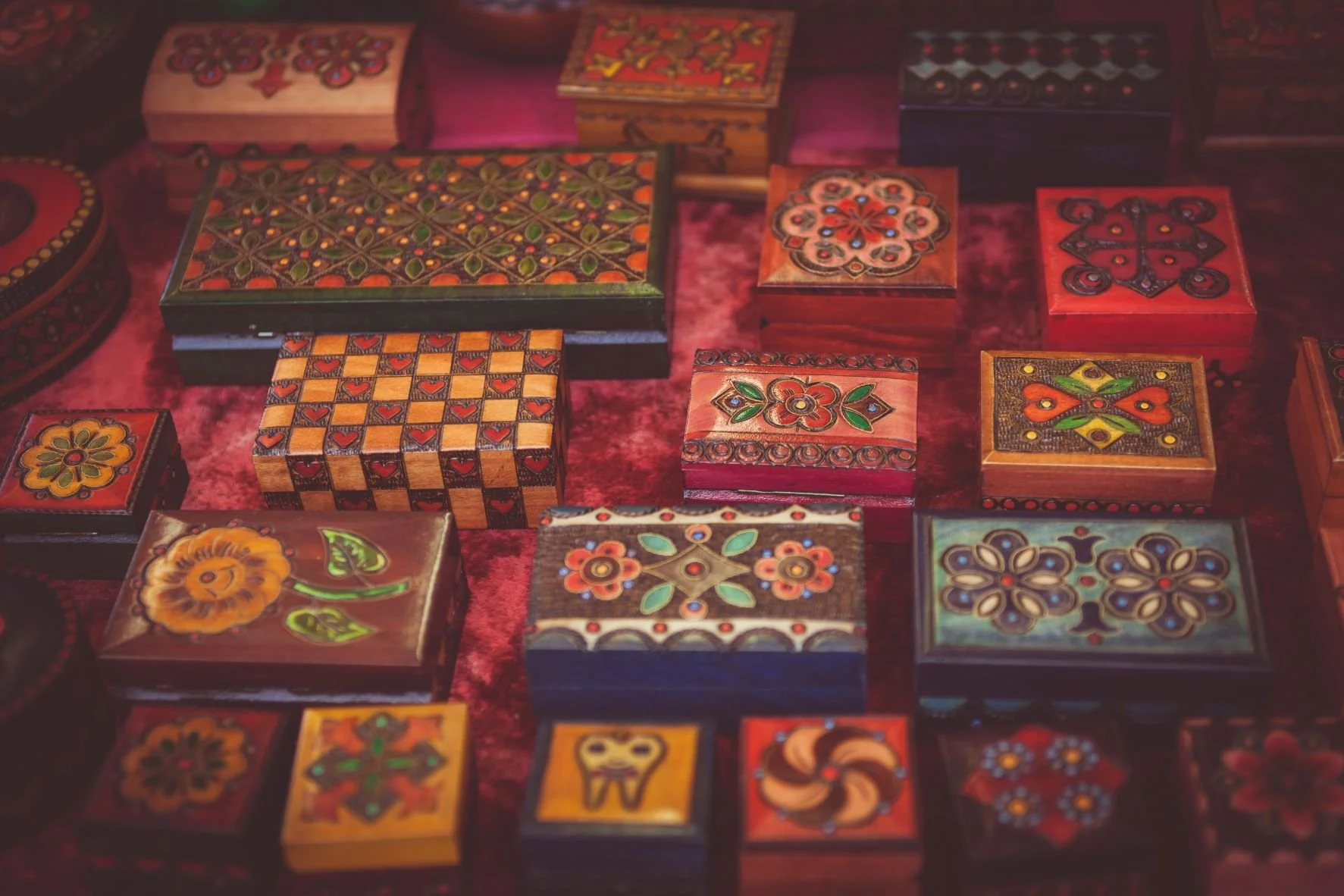The Tool Kit
Let’s assess where we stand in terms of our Muse-inspired projects. The hardest parts are behind us—if we don’t count the writing. We have our idea. We have a space to play and work. Now comes an enjoyable bit—assembling our tools.
Writers often refer to their knowledge of techniques taught in classrooms and those acquired through experience as their “tool kit.” Personally, I’ve not met a writer yet who showed up anywhere with a physical kit full of information (unless we’re talking books). It’s fun to imagine how our own tool kits would look if they appeared in reality. A fly-fisher’s tackle box? A sculptor’s canvas role of chisels? A doctor’s old-fashioned gladstone bag? I imagine mine as a collection of bright, small boxes similar to those in the opening image. Each would offer space enough for only one bit of advice, and I would be forever forgetting which piece I stored where.
Less renown in our set of tools are the can’t-write-without items such as the favorite mug with the chipped handle, the tea or coffee of choice, the motivating music—or not, blank notebooks (even though I have space enough in others), and of course, the correct pens, pencils, keyboards and screens waiting to fill the world with unbridled brilliance. Some of us travel with favorite books on writing in printed text or on an E-book reader. And never underestimate the power of totems such heart-shaped stones or a significant tarot card. Most important, we must carry a bottomless well of pep talks and phone numbers needed to fend off the Anti-Muse we call Imposter Syndrome.
I imagine mine as a collection of bright, small boxes similar to those in the opening image. Each would offer space enough for only one bit of advice, and I would be forever forgetting which piece I stored where.
We can get a photo-accurate idea of the true of shape of each of our tool kits by stopping before a convenient mirror. The image we see reflects the location of our real tools, the ones that wait buried within us: our minds, our hearts, and whatever mysterious sense of the mysterious we call our souls.
In truth, those three are the only real necessities of writing. Yes, we need ink or graphite or pixels to make words live on paper, the gracious gift of trees. (Say “thank you” when you open a notebook or fresh ream.) We understand we are the source of our writing as fact, and yet, our faith in certain brand names or sacred objects, prove our superstitious wish for a magic that will make writing easy.
If we define easy as comfortable, writing is the opposite of easy. No news there. To write well requires courage and discipline and perseverance in the willingness to reveal our mind, heart, and soul to others in hopes of reaching the same in them. Once we’ve pulled ourselves to the top of that mountain, we have to work and rework and rework existing work so it possesses the purest clarity and richest resonance we can muster.
What store in the world sells tools for this kind of endeavor? Not a one. We come equipped for this work, wired with everything we need from birth. But, as with most treasures, we must dig deep to reach them. The digging is what makes writing so uncomfortable with its constant self-questioning of “Am I good enough?” In the uncertainties of this kind of work, who would deny us our faith in particular green notebooks or our preference for blue-penned edits as they read less editorial than the red or the vanilla-chai tea in the chipped mug.
Go forth to your office supply store during back-to-school sales and stock-up. Go forth to walk the woods or shore to collect those heart-shaped stones. Get yourself an old box, a tote bag, a backpack to carry your essential tools in. Put the kettle on or open the bottle of wine or break into the box of mocha truffles. We need what we need.
Next week, we write.
Writing Exercise
Writing is a pas de deux. That’s the ballet term for two dancers moving the story forward on stage. Without them both dancing together, the power of the story is lost. Writing is not ballet, but still, without readers, our pas de deux partners, our writing may as well not exist. When the writing has gone well, the writer’s presence will be subsumed by the story. The reader may never think of us. At least, that’s our ambition. Maybe this is why books have author photos? They provide a proof of our lives. If you were to include a letter directly to the reader at the end of your book, what would you want to tell them about how the story that swept them up came into being? Write that letter. Write about the concrete details of what you needed to get your book done. You worked long and hard to make your story unfold effortlessly for the reader. Tell them how much effort and time that takes.
Photo by Clem Onojeghuo on Unsplash

